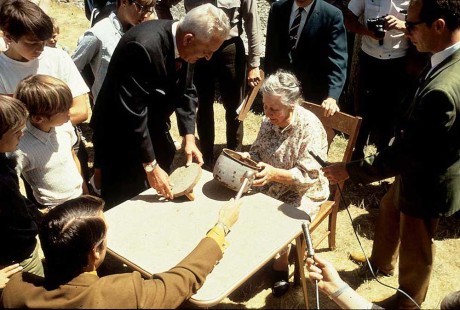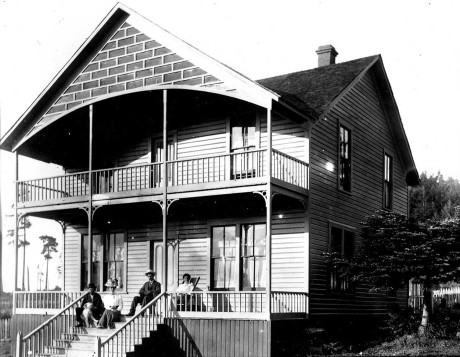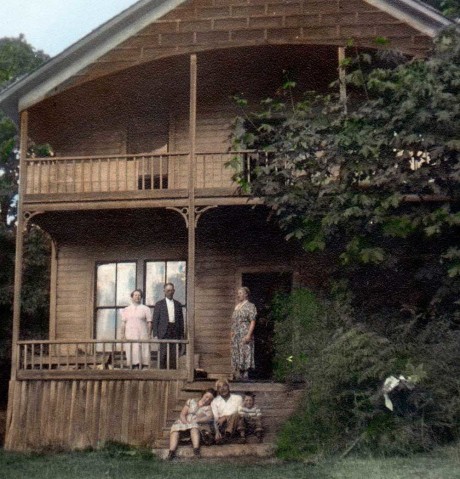Crook House Open for Tour
Posted May 16, 2013 at 4:07 pm by Tim Dustrude
Correction – – The location for Friday evening’s presentation is at the Historical Museum’s Resource Center on 405 Price Street – not at the library as was previously reported.
When master carpenter William Crook arrived on San Juan Island with his wife and two children in November 1875 he had come to the end of the line in a journey that began when he left his native Yorkshire in 1856.
Learn more about how this legendary family came to embody pioneer self-sufficiency and the island way of life during this evening Power Point presentation with Park Ranger Doug Halsey and San Juan Island Historical Museum Executive Director Kevin Loftus scheduled at 7 p.m., Friday, May 17, at the San Juan Historical Museum’s Resource Center, 405 Price St. Halsey and Loftus will be joined in a discussion by several long-time island residents with memories of the Crook farm and family.
The program will continue the next day (Saturday May 18) with an open house of the Crook house at English Camp. The open house will be hosted by San Juan Island NHP and historical museum staff and volunteers as a part of the museum’s Historical Home Tour. It will be the first time the 1903-vintage house has been open to the public since the park was created by Act of Congress in 1966.
The evening event is free. For information on home tour tickets, contact the museum at 378-3949. For accessibility information call the park at (360) 378-2240, ext. 2228, or the museum at the same number above.
Halsey will show more than 100 images in a program that documents the family and site history from the archives of San Juan Island National Historical Park. The home tour will be limited to the two-story house’s first floor, as the second floor, which was never finished, is not suitable for visitation. The front porch also will be closed to visitors.
“Visitors also should be aware that the first floor was remodeled over the years to accommodate 20th century comforts such as wall heaters, insulated ceilings, a modern bathroom and a 1960s-era rear addition that includes a modern kitchen,“ Vouri said. “However, save for those features, the basic Edwardian floor plan remains intact, including the original door frames, a unique sliding door that leads to the parlor, and the spectacular view of the parade ground from the front windows.”
William Crook made a beeline for the site of the former Royal Marine Camp, which he learned was ripe for the plucking among the unclaimed acreage on the island while negotiating the old Oregon Trail through Idaho.
On arriving at the old campsite nestled along the shore of Garrison Bay, Crook found a cleared, though weedy, parade ground accommodating 27 intact structures, including two barracks, a storehouse, docks and two fine houses. This ready-made homestead was the “English Camp” Crook had heard about while on the Oregon Trail with his wife, Mary Forrest, and two children, Jim and Mary. The family would call it home for the next 100 years and leave a lasting legacy for the American people.
After the Royal Marines left in 1872, the site was surveyed and inventoried by the U.S. Army for a public auction held on November 24, 1875. A stipulation was that all purchases were to be removed from the site within 60 days or become the property of the land claimant.
The family occupied several marine structures over the years, including the “Lieutenant’s House” (where Rhoda was born in 1878), library and barracks—the latter serving as the National Park Service’s visitor center on site. In addition to several island residences, William Crook built boats in the old storehouse. He also planted apple, pear and cherry trees on the old parade ground, and by 1900 was selling eggs, chicken, sheep, wool and fruit.
Mary Forrest Crook died in October 1899, followed by William in 1901. Rhoda and Mary quit-claimed their shares of the estate to Jim, both having married married in 1897 and 1900 respectively. Mary and her husband, Herbert Davis, moved into the house with Jim in 1903.

William stashed the family savings in a chamber pot, hiding it under the trap door to the attic he’d added to the old Royal Marine barracks when the family used it as a primary domicile for many years. When William died he had told his children where the money was hidden. It was not found until the National Park Service dismantled the structure for reconstruction in the early 1970s. By then only the youngest child, Rhoda was left alive. The money was turned over to her. The story created quite a media stir, which is what this photo is all about.
Though most of the farm’s 272 acres were under cultivation by 1911, Jim Crook also made barrels for 95 cents apiece and was famed as a tinkerer. A local favorite is the 20-foot-long, two-ton, wool-carding machine, still on display at the San Juan Historical Museum.
With no heirs, Jim and Rhoda donated the parade ground to Washington State. At the same time, U.S. Sen. Henry M. Jackson submitted legislation creating San Juan Island National Historical Park. It was signed into law seven months before Jim died, at 93, in March 1967. In June 1968, the National Park Service purchased the remaining Crook acreage from Rhoda, who was given lifetime tenure in the house above the parade ground and the three acres surrounding it.
Rhoda Anderson often chatted with visitors from her kitchen window, and remained a cheery presence in the park until her death at 92 in 1972.
You can support the San Juan Update by doing business with our loyal advertisers, and by making a one-time contribution or a recurring donation.
Categories: Around Here












No comments yet. Be the first!
By submitting a comment you grant the San Juan Update a perpetual license to reproduce your words and name/web site in attribution. Inappropriate, irrelevant and contentious comments may not be published at an admin's discretion. Your email is used for verification purposes only, it will never be shared.